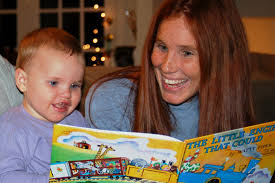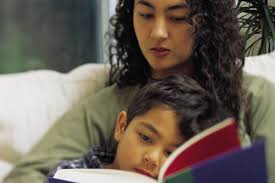Established & edited by Jessica Becerra, Elizabeth Esparza, & Audrey Ochoa
Extended by Jessica Chaffee, Mara Mareti, & Annette Markovich

Impact of Home and Parent Programs on Young Children's Early Literacy Skills

Table of Contents:
1. Abstract
2. Summary
3. Limitations
4. Successful Home and Parent Programs
5. Home based Activities for Parents
6. Additional Parental Resourses
7. References

1. Abstract
In this chapter, we will be looking at the value of home and parent programs and specifically their effects on improving children’s early literacy development. We will provide information on various successful programs that are currently available for families. Also included in this section will be ideas for parents on how to help their children with their early literacy development. We will look at some simple, low-cost activities that parents can implement at home with their children.




2. Summary
The National Early Literacy Panel analyzed the impact of home and parent programs on the early literacy development of children between the ages of zero to five. Previous studies have indicated a positive influence on children’s literacy skills that come from homes where parents engage their children in various literacy activities. The Panel chose nine variables to be monitored in a total of 23 studies, those variables were; Alphabetic Knowledge, Coginitive Ability, Memory, Oral Language, Phonological Awareness, Reading, Reading Readiness, Spelling, and Writing. The NELP intended to determine to what extent these interventions benefited the children and their literacy development.
The results from the analysis of these interventions indicated a positive outcome on oral language and cognitive abilities. It is possible the interventions provided other literacy benefits but because of the many additional factors, such as ethnicity and socioeconomic status, no absolute conclusions could be made. Though parent and home programs were successful to some extent more thorough studies need to be done to solidify which programs have the most success with which populations.
3. Limitations
Several limitations occur in the National Educational Panel’s Report that makes creating conclusions difficult. A total of 23 studies met the criteria for the home and parent early literacy study. The first problem with the studies is that the small amount does not allow analysis of the impact of population variables such as SES, ethnicity, or population density. A second problem with the studies is that they are all extremely different. The studies vary from programs dealing with home visits, training parents, and speech therapy. The lengths of time of these programs differ as well. Many programs were for a limited amount of months as opposed to one study that occupied a 4 year period. The only similarity across all studies is that they involved parents as the agents for intervention.
The majority of programs in the study were delivered to parents by the developers of the interventions and were supervised closely by developers. In a normal circumstance, this would not be the case for many parents. Would the programs and results still be the same if a school or parent implemented the program alone?
Possible limitations of the NELP report include that reading/literacy is such a complex, overlapping system (see )http://earlyliteracyci5823.pbworks.com/Definitions, that the panel could only test the components of literacy that lend themselves to testing. While the NELP panel's conclusions are based on academic research, and they will no doubt help future researchers as to uncover more viable facts about early literacy, the panel report gives the impression that teaching reading should be a fragmented exercise. This is problematic, as there are students at risk who know the letters and sounds of the letter, they know the meaning of the individual words, but they can't put the meaning together in order to actually comprehend the text. These students have all of the pieces but they can't see the whole picture. This website reinforces the value of reading instruction in a more holistic manner and offers many successful programs that have a positive history of helping parents promote early literacy.
For more detailed infromation about this topic see: Educational Researcher, (2010) American Educational Research Association. Volume 39, Number 4 May 2010.
4. Successful Home and Parent Programs
Reach Out and Read
Reach Out and Read is a nationwide program with the goal of promoting early literacy by providing -books to children ages 6 months through 5 years old. While parents bring in their children for check-ups and exams, medical professionals advise parents about the importance of reading. Pediatric healthcare providers are trained in the Reach Out and Read Model by offering age appropriate tips and materials to parents. The waiting room is also adorned with a print rich environment, books, and possibly a volunteer modeling read-alouds for parents. ROR is currently serving one-third of American children living in poverty with 4,545 programs in the U.S providing books to 3.9 million children.
www.reachoutandread.org

Reading is Fundamental
Reading is Fundamental began in 1966 with a teacher providing books for three students she was tutoring and now has increased to the largest literacy program in the nation. RIF offers millions of books to children in different settings such as school, community, Boys and Girls Clubs, and hospitals through its Book for Ownership program. Books for Ownership allows children to choose paperback books with festive literacy activities in over 25,000 sites in all 50 states.
Reading is Fundamental contains several programs that encourages parent involvement. One program in RIF called Shared Beginnings teaches parents the importance of literacy and provides guidance and practice for parents to engage their children with reading. Parents are taught rhyming games, songs, how to choose books, and read-alouds. Family of Readers is another program dedicated to educate and encourage parents of at-risk children to read at home as a family. The parents are then asked to continue in the education process by participating in teaching other parents. Running Start is the third program that involves children, parents, educators, and community. First graders are challenged to read 21 books in eight to ten weeks. Parents and educators are asked to provide encouragement and help to young readers.
www.rif.org

The Parent-Child Home Program
The Parent-Child Home Program is a research-based program that began in 1965. It focuses on early childhood literacy, parenting, and school readiness. This program also focuses on equipping parents with the necessary skills to enhance their children’s abilities. Families can begin the Parent-Child Home Program when their child is two years old, and in some cases, even as young as eighteen months. This program provides home visits for families whose children might not have the same educational experiences as others due to poverty, language barriers and other hindrances in an attempt to prepare them to enter school. During this two-year program, families are visited by a trained Home Visitor twice a week for half an hour which is based on the parents’ schedule. Each week, the Home Visitor introduces new books, educational toys, and models verbal interactions that will help children improve their language and literacy skills. Some of the families that are helped by this program include low income and homeless families, multilingual and non-native English speakers, as well as single parent and teen parent families. The Parent-Child Home Child Program has had great success with its participants.
http://www.parent-child.org/
" />
Chicago Child- Parent Centers
Chicago Child-Parent Center is a Title I funded early education program for children 3-5 years of age. Child-Parent Centers are located in low income areas and is supported by No Child Left Behind. The children receive two years of service to develop basic reading, writing, and math skills. Parents are required to participate in two classroom activities a month on a variety of topics such as nutrition, child development, and reading readiness. Although this is a large and common initiative, this program was not included in NELP’s report.
Home Instruction Program for Preschool Youngsters (Hippy)
The Home Instruction Program for Preschool Youngsters is a study used by the National Early Literacy Panel to create their analysis. HIPPY is a two-year home based early education program created to help parents with limited formal education to prepare their four and five year old children for school. The program aims to enhance the home literacy environment, the quality of parent-child interaction, and parents’ ability to help their children learn. The program consists of bimonthly visits by paraprofessionals who live in the same neighborhood who provide a structured program with set lesson plans. Home visits are important to give individualized attention, eliminate transportation issues, and create strong relationships among participants. In the alternating weeks, parents met as a group to mingle and discuss questions and concerns. HIPPY children outperformed the control group on measures of cognitive skills at the end of kindergarten. However, none of these effects were replicated in a second trial (Baker, Brooks-Gunn, & Piotrkowski, 1998).
5. Home-based Activities for Parents
According to the article More Than Just Storybooks: Promoting Emergent Literacy Skills in The home from Childhood Education "Parents do not need to teach formally, but rather scaffold their children's experiences."
****Listed are some activities parents can enjoy at with their children. These
activities are intended to be low-cost, simple, and enjoyable for both parent and
child. Giving parents practical ways to introduce and encourage literacy activities
could benefit future literacy development.****

- Reading - when reading, discuss what they see on the page, ask open-ended questions about the story

- Writing - allow children time for free writing which may consist of scribbling or drawing, form letters out of clay, string, blocks, cooked spaghetti, etc. (Do not limit to writing to pencil and paper)
*For a fun activity go on a nature scavenger hunt. Track down each letter of
the alphabet somewhere
in nature, using a digital or disposable camera. Look for an A in a tree branch, a
B in a cloud, or a C in the curve of a squirrel’s tail.
- Reciting rhymes - recite rhymes such as Old MacDonald or Twinkle, Twinkle Little Star, then try to make up your own
http://www.succeedtoread.com/rhyme.html
*Easy rhyming activity thats easy today and can be used almost anywhere.
- Literacy-based play interactions - dramatize storytelling, re-enacting stories through plays and puppet show, set up literacy rich play settings such as a pet shop or grocery store with props, signs, and logos.
*Don't throw away old socks! They make great props. All you need is a
permanent marker and voila!
- The Ups and Downs home-based strategy - This strategy provides an interactive approach using multisensory learning. If the child is looking at a milk carton they use their visual to look and point at the letter 'M'; they use auditory to describe the sound; kinesthetic is used to form the letter with body movements (ex. air writing) and tactile is used by tracing the letter with their finger.
*To learn more about the different types of learning styles click
here http://school.familyeducation.com/intelligence/teaching-
methods/38519.html
- Interactions with environmental print - point out food packaging, product labels, and road signs
http://libweb.lib.utsa.edu/login?url=http://proquest.umi.com.libweb.lib.utsa.edu/pqdweb?did=1705200361&Fmt=7&clhttp:
ientId=2944&RQT=309&VName=PQD
6. Additional Parental Resources:
http://www.readwritethink.org/ wonderful reading activities for many grade levels, theme, and specific books.
http://www.pbs.org/parents/ blogs, activities, interactive activities.
http://www.softschools.com/ phonics, language arts, science, and math games. Plus holiday activities.
http://childparenting.about.com/ parenting blog and information.
http://www2.scholastic.com/browse/home.jsp wealth of resources some free some by subscription from printable minibooks, Scholastic News, to teaching resources.
www.fountasandpinnellleveledbooks.com has leveled books for sell and ideas on how to use them.

7. References
Baker, A., Brooks-Gunn, J., & Piotrkowski, C.S. (1998). A home instruction program for preschool youngsters (HIPPY). The
Future of Children. 9(1), 116-133.
National early Literacy Panel. (2008). Developing early literacy: Report of the National Early Literacy Panel. Washington, DC:
National Institute for Literacy.
Neumann, M., & Neumann, D. (2009). More than just storybooks: promoting emergent literacy skills in the home. Childhood
Education. 85(4), 257-260.
http://school.familyeducation.com/intelligence/teaching-methods/38519.html
www.parent-child.org
www.reachoutread.org
www.rif.org
www.succeedtoread.com/rhym.html
Comments (0)
You don't have permission to comment on this page.